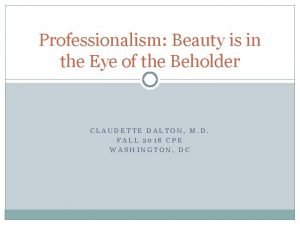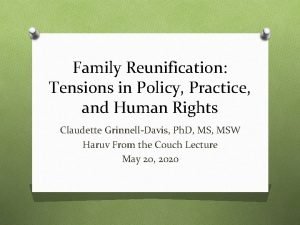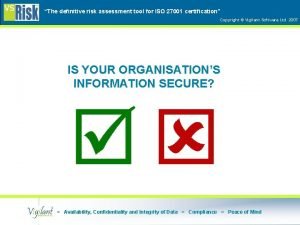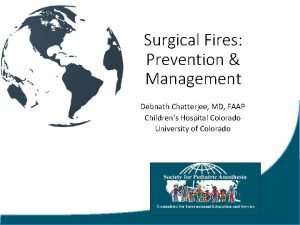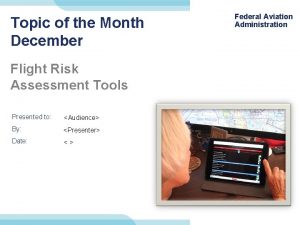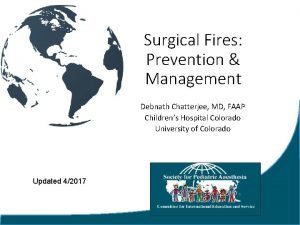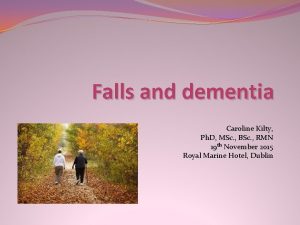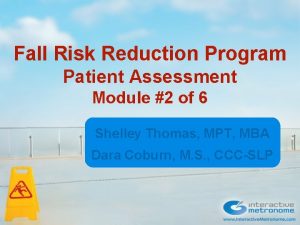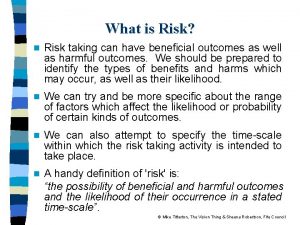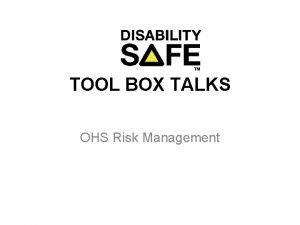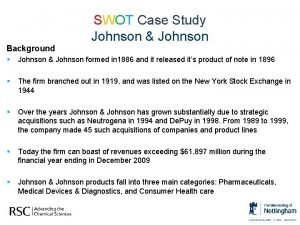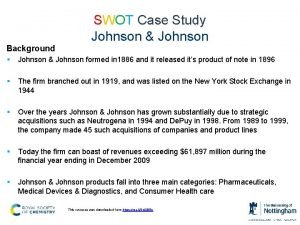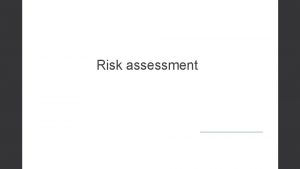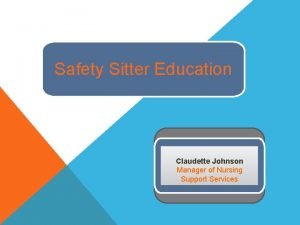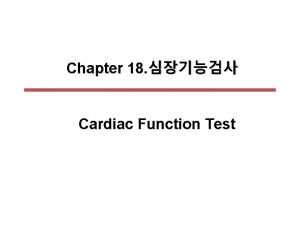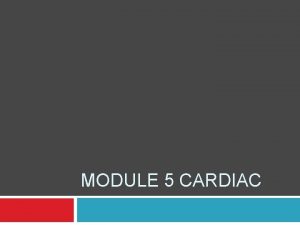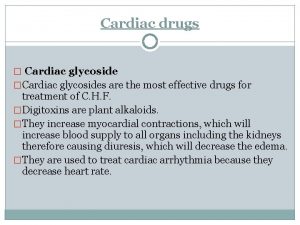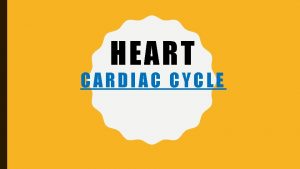CARDIAC RISK ASSESSMENT TOOL Claudette D Johnson Grand














- Slides: 14

CARDIAC RISK ASSESSMENT TOOL Claudette D. Johnson Grand Canyon University NUR: 645 E Advanced Health Assessment for Nurse Educators January 30, 2013

Objectives 1. 2. 3. Identify and describe a health risk assessment tool Conduct, analyze, and report results of a survey utilizing the tool Analyze the tool based on validity, reliability and readability and appropriateness for the tool’s intended audience

Risk Assessment Tool: Framingham Description Reason for choice l l l Risk Assessment Tool for estimating 10 -year risk of having a heart attack This tool is designed for adults aged 20 years and older who do not have heart disease or diabetes Widely used tool assisting in nationwide efforts to control the prevalence of heart disease and other diseases (Sheridan, Pignone & Mulrow, 2003) l Used to identify interventions to help decrease cardiac diseases and death which meets the goals of the Million Hearts initiative, Healthy People 2020, and the American Heart Association 2020 (American Heart Association (AHA), 2012) l (Sheridan, Pignone & Mulrow, 2003) Effective primary and secondary prevention could prevent or postpone as many as 56% of all deaths among people aged 30 to 84 years (Kottle, Jordan-Baechler & Parker, 2012)

Framingham Tool Measures Total Cholesterol HDL Cholesterol Gender Age Smoking Increase risk of heart attack Systolic Blood Pressure (Sheridan, Pignone & Mulrow, 2003)

Framingham Cardiac Risk Assessment Tool AGE The older the higher risk TOTAL CHOLESTEROL Borderline High HDL SMOKER CHOLESTEROL Smoked in last month? Major risk < 40 mg/d. L 200 - 239 mg/dl High Greater than 240 mg/dl Yes No SYSTOLIC BLOOD PRESSURE Take top number of reading DIABETES Yes No Moderate risk 40 -59 mg/d. L Low risk >60 mg/d. L (Sheridan, Pignone & Mulrow, 2003).

(Sheridan, Pignone & Mulrow, 2003)

Survey Results 53 y/o Male 25 y/o Male 41 y/o F 74 y/o F 25 y/o F 61 y/o M 69 y/o M 37 y/o F 78 y/o M 54 y/o F Age 6 -9 0 14 -7 10 11 -3 13 6 Smoker 3 0 7 0 0 0 4 Total Cholesterol (335)=5 (155)=0 (131)=0 (210)=1 (169)=4 (242)=2 (193)=1 (178)=4 (105)=0 (175)=2 HDL Cholesterol (41)=1 (65)=-1 (38)=2 (76)=-1 (55)=0 (92)=1 (48)=1 (43)=1 (27)=2 (34)=2 Systolic BP/BP Meds (124) (no)=1 (119)(no)= 0 (125) (no)=1 (132) (no)=2 (126) (no)=1 (106) (yes)=0 (131) (yes)=2 (110) (no)=0 (160)(no)= 3 (154) (yes)=5 16 -10 10 16 -2 11 15 2 18 19 25% Less than 1% 1% 4% 0% 8% 20% Less than 1% Equal to >30% 8% Total: 10 year Risk

Survey Analysis l l l Equal comparison of data between men and women Women <50 have lower risks for heart disease. Scores are significantly lower due to smoking status (70% nonsmokers) Total cholesterol levels greater than 200 added a greater number of points to the total score of these individuals when compared to other categories HDL (“good” cholesterol) levels did not seem to affect the total scores by large amounts l l For women, hypertension added larger points to the total scores than for men. It is important to remember that the presence of any one of these risk factors may warrant further attention even if the 10 year risk dose not appear to be high(NHLBI, n. d. ).

Readability Evaluation tool l l l Flesch Reading Ease Scale Uses average sentence and word length Word difficulty measured by use of syllables per word Syntactic measured by words per sentence Score of 0 -100 Score of 0 -40 indicates difficult to read Score of 80 -100 indicates easy to read Norm: 60 -70 words is acceptable readability Result Flesch Reading Ease Scale l l l Acceptable readability Easy to understand Responses to questions: simple responses, data known to users, response requiring yes or no responses Shortcoming: HDL and total cholesterol levels require testing Responses calculated by hand or calculator (Stockmeyer, 2009; Ancker, 2004)

Appropriateness for Audience Evaluation tool Result Flesch- Kincaid Grade Level Scale l Reflects the minimum grade level necessary to understand reading a document (Ancker, 2004) l Formula: reading grade level = (0. 39 x average sentence length) + (11. 8 x average syllables per word) -15. 59, with college level reading equaling to Grade 16 (Ancker, 2004) l Stockmeyer (2009) suggests a grade level score of 7 -8 as a norm. Flesh-Kincaid Grade level scale score of 7. l Indicates appropriateness for its intended users (ages 20 and up) l Words used are direct and easy to understand l Responses required are simple (Stockmeyer, 2009; Ancker, 2004)

Reliability l l l Men Women Ethnic Groups l l Predictor of 10 year coronary heart disease risk accuracy-95% and 83% Predictor of 2 year coronary heart disease risk accuracy-67% and 98%

Validity l l Research mostly supports the tool’s validity Some concerns were identified l l Ethnic Populations -metabolic syndrome Women -minority -elderly

Conclusion The Framingham risk assessment tool: Calculates one’s risk of the heart attack Appropriately analyzes data from randomly selected individuals ages 20 and above and easily determines cardiovascular risk Meets the standard readability Found reliable as written in many literature and valid except for some concerns identified when testing certain ages, women, and ethnic groups.

References American Heart Association (2012). Heart attack risk assessment. American Heart Association Organization. Retrieved from: http: //www. heart. org/HEARTORG/Conditions/Heart. Attack. Tools. Resources/Heart. Attack-Risk Assessment_UCM_303944_Article. jsp Ancker, J. (2004). Developing the informed consent form: A review of readability literature and an experiment. AMWA Journal. 19(3), 97 -100. Batsis, J. & Lopez-Jimenez, F. (2010). Cardiovascular risk assessment: From individual risk prediction to estimation of global risk and change in risk in the population. BMC Medicine, 8, 29. Doi: 10. 1186/1741 -7015 -8 -29. Coke, L. (2010). Cardiac risk assessment of the older cardiovascular patient: The Framingham global risk assessment tools. MEDSURG Nursing. Retrieved from http: //consultgerirn. org/uploads/File/trythis/try_this_sp 3. pdf. Gleeson, D. & Crabbe, D. (2009). Emerging concepts in cardiovascular disease risk assessment: Where do women fit in? Journal of the American Academy of Nurse Practitioners, 21, 480 -487. Doi: 10. 1111/1745 -7599 -2009 -00434. Kottle, T. , Jordan Baechler, C. , Parker, E. (2012). Accuracy of heart disease prevalence estimated from claims data compared with an electronic health record. Preventing Chronic Disease. 9 (1). DOI: http: //dx. doi. org/10. 5888/pcd 9. 120009. Retrieved from: http: //www. cdc. gov/pcd/issues/2012/12_0009. htm National Heart, Lung, Blood Institute (NHLBI) (n. d. ) National cholesterol education program, third report of the expert panel on detection, evaluation, and treatment of high blood cholesterol in adults (adult treatment panel III). National Institutes of Health (NIH). Retrieved from: www. nhlbi. nih. gov/guidelines/cholesterol/index. htm Sheridan, S. Pignone, M. & Mulrow, C. (2003, December). Framingham-based tools to calculate the global risk of coronary heart disease: a systematic review of tools for clinicians. Journal of Internal Medicine. 18 (12). 1039 -1052. Retrieved from: http: //www. ncbi. nlm. nih. gov/pubmed/14687264 Stockmeyer, N. (2009). Plain language. Michigan Bar Journal. 46 -47.
 Claudette dalton md
Claudette dalton md Iridescent shards dead by daylight
Iridescent shards dead by daylight Claudette grinnell-davis
Claudette grinnell-davis Credit risk market risk operational risk
Credit risk market risk operational risk Iso 27001 risk assessment tools
Iso 27001 risk assessment tools Fire risk assessment surgery
Fire risk assessment surgery Kirat risk assessment
Kirat risk assessment Flight risk assessment tool app
Flight risk assessment tool app Silverstein fire risk assessment tool
Silverstein fire risk assessment tool Ohs risk assessment tool
Ohs risk assessment tool Fire risk assessment aorn
Fire risk assessment aorn Dewing wandering risk assessment tool
Dewing wandering risk assessment tool Fall risk assessment tool
Fall risk assessment tool What is risk
What is risk Hazpak risk assessment tool
Hazpak risk assessment tool
